8. OPEN SOURCE HARDWARE: from fibers to fabric#

Introduction to the world of spinning / Workshop STUDIO HILO#
The assigment of this week, was really a challenge for me: To build your own machine, to make it work and perform or perfect “something” with the result of it … It was an intense week but very fruitful and stimulating. It began with the arrival of Natalija and Sara from Studio Hilo (Berlin) which introduced us in a very didactic way in the world of spinning; from its ancestral and manual process to the current machines and softwares. His work is specialized in this field, innovation in Spinning through his own machines which have a direct interaction with the user:
The spinning machine HILO challenges the process by which yarn is produced, making it more efficient, personalised, and sustainable. HILO enables the user to determine the textile properties at the very beginning of its manufacturing process, the yarn spinning. The HILO software translates a desired pattern or an image into a yarn thickness, which can vary from very light and loose to hard and thick. After the yarn is spun, it can be used in a preferred textile construction technique. With unique tactile and aesthetic qualities, a finished piece can be applied in textile, fashion, interior or industrial design. The innovation of HILO lies in its flexibility and ability to produce yarn of desired tactility in a single spin. It is also sustainable, as it produces only the required amount of yarn. HILO reinvents textile manufacturing by reevaluating the potential of traditional yarn spinning techniques.
The next step was the real presentation of his first spinning machine, which we had to build step by step in groups of 2 people (previously predetermined by a series of questions and answers, which took us to our closest companion for this mission) in my case: Ana Correa, with whom we form a great team.
Links#
HILO from Studio HILO on Vimeo.
Aurora: our spinning machine#
Aurora, is the name we decided to give to our spinning machine; to which we took great affection from the first moment he started to turn. Step by Step:
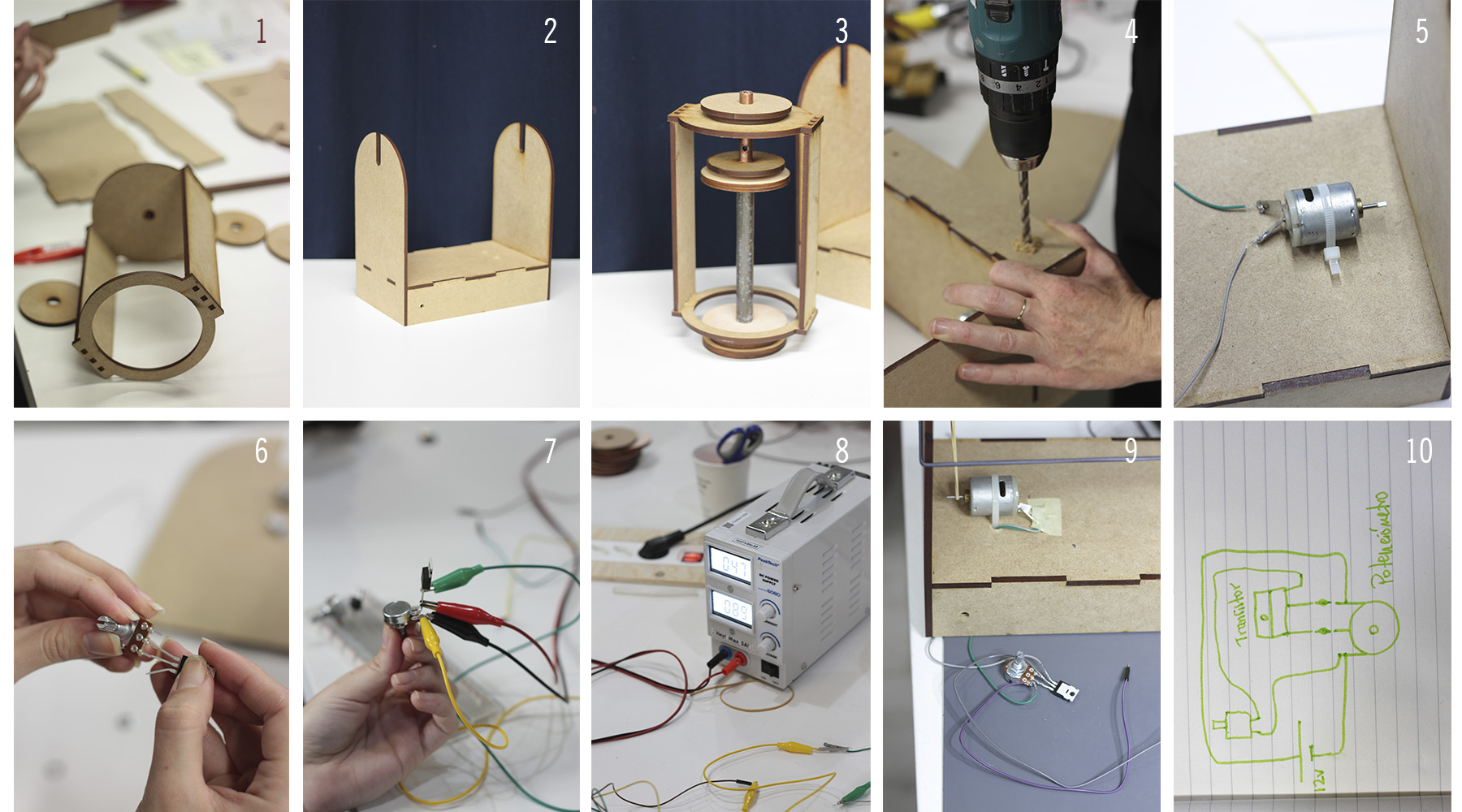
- 1 Identify the parts of the machine, secure the inserts with carpentry glue.
- 2 Mount the body-support of the machine in the first place.
- 3 Then the rotating reel and the removable with their respective tubes.
- 4 Perform perforations for the exit of cables, entrance and exit of the elastic that controls the twisting and other smaller ones in the revolving reel to place the self-piercing eyelets.
- 5 Position and secure the motor with seals. Solder the positive and negative output cables.
- 6 Identify and solder the connection between the Transitor and Potentiometer of the machine.
- 7 Perform electrical connection test using crocodiles, breadboard externally identifying the circuit.
- 8 Verify the correct operation of the motor through a power source. The proper voltage for our machine was 12V.
- 9 Reinforce the welds of the circuit, place the potentiometer internally, leaving only the rotary knob visible.
- 10 Drawing of the circuit.
Week 08. OPEN SOURCE HARDWARE - From Fibers to Fabric / Testing spinning machine from Betiana Pavon on Vimeo.
Spinning process#
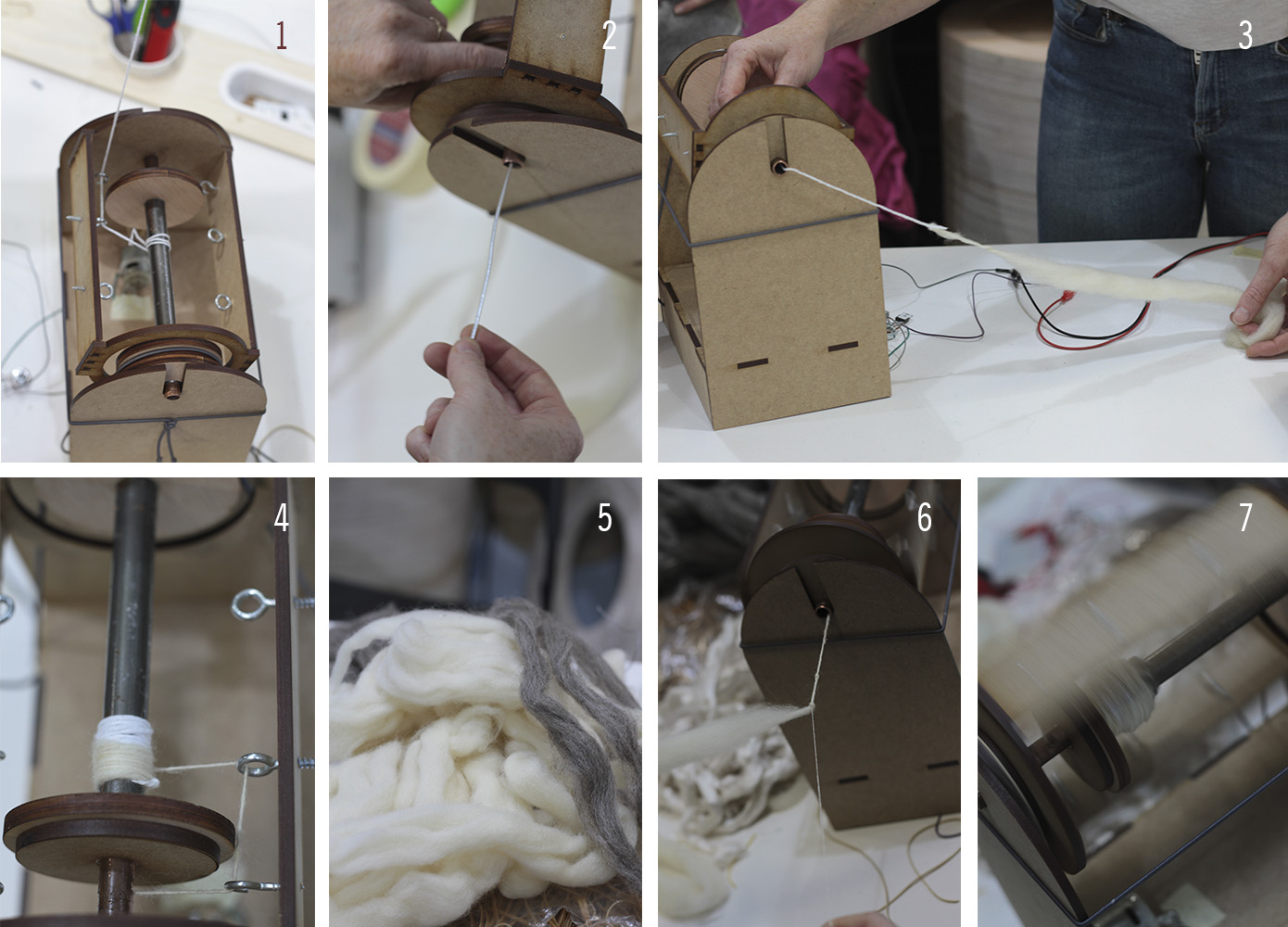
Week 08. OPEN SOURCE HARDWARE - From Fibers to Fabric / Yarn process from Betiana Pavon on Vimeo.
- 1 Once the machine is finished, place the elastic that controls the twisting and the elastic band that pulls the rotation through the motor. Tie a twisted yarn (preferably cotton) to the reel tube with enough length so that it passes through the eyelets and exit through the axle tube of the machine.
- 2 To remove the end of the thread (initially and as many times as necessary throughout the spinning process) we create our own hook needle, similar to the one used in wire crochet.
- 3 Link the selected fiber and start the machine. It will begin to rotate and “pull” the fiber, which we must control with both hands; with one we stop the torzado and with the other we extend the fiber to obtain the thickness of the wished thread. It is a process that for me personally, it took a lot of practice to get familiar with the times of the machine and those of my manual speed; but once it’s underway it’s almost a “therapy” you can spend hours and hours spinning, experimenting with different fibers, thicknesses.
- 4 The different buttonholes of the spinning reel allow us to thread the yarn along it, in order to achieve a ball of uniform yarn.
- 5 At first it is advisable to use wool for spinning, since its filaments are longer and more flexible, allowing greater manual control. You can mix colors and thus form your own thread in degradee.
- 6 Conductive yarn: thinking about future applications, we conduct yarn tests with conductive yarn internally wrapped (enlisted) in wool. This technique requires greater precision and dexterity since a fiber is held in each hand.
- 7 I recommend trying all the textile fibers you can, as it is very different with each of them, both in the process, and in the final result.
About textile fibers#
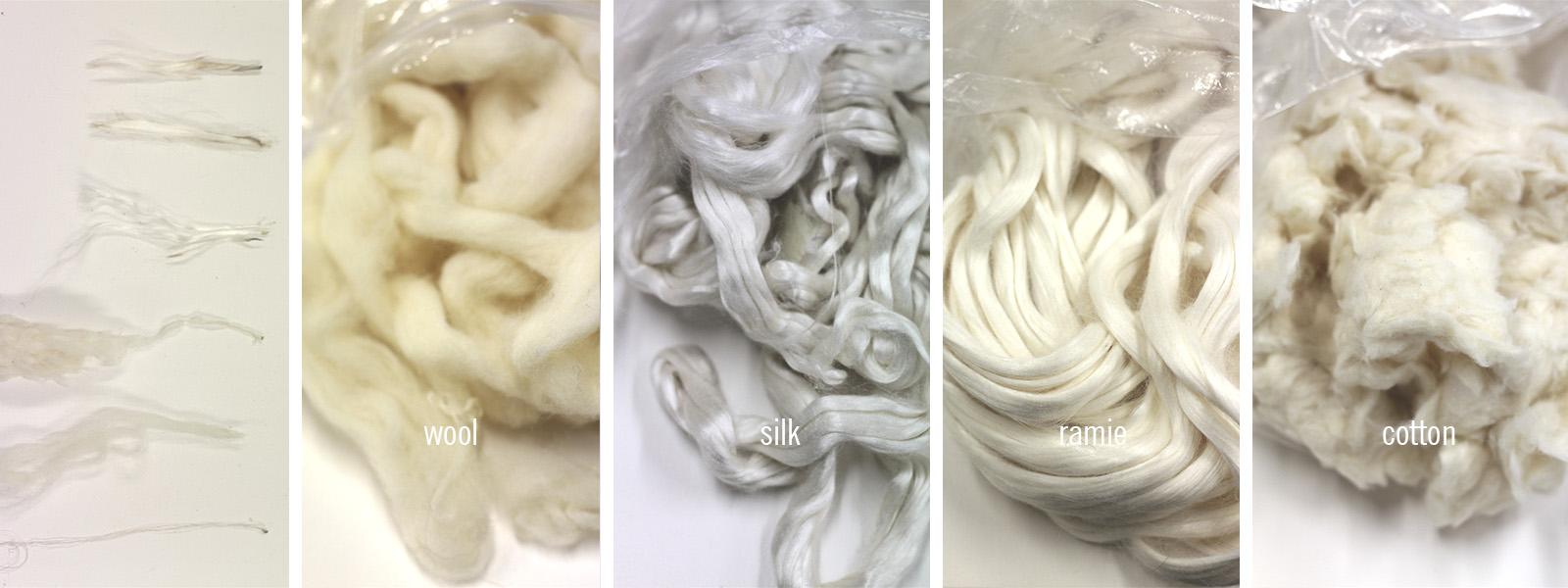
In this first experimentation with spinning, we decided to use fibers of natural origin such as wool, silk, ramie and cotton. To identify whether they are natural or plastic we can use the “trick” of burning the fiber, by its smell (the natural ones have a sweet aroma and some smell of burned hair) and by the reaction of it (the plastic melts) we can classify them. As I have already mentioned, the most faithful fiber to start spinning is wool, then another fiber can be introduced in the yarn, mixing materials and thus see and analyze performance. Silk, obviously has a beautiful finish, but it is a hard fiber to spin; of similar finish but with greater flexibility we find the Ramie (it is a flowering plant in the Urticaceae nettle family, native to eastern Asia). Cotton, one of the noblest textile materials, has short and less flexible filaments, but is very soft to the touch to spin.
The yarn applied in my personal project / Hilo Hat#
After spinning many hours, I had to think I could do with all that material achieved 50% by the machine and 50% with my hands. The mixture of thicknesses and materials was worthy of being in view in a final product. Inspired by the work of Wendy Andreu in her progento Regen, I decided to apply this technique creating my own volume to tighten and shape through the thread: piluso style hat, which in a single volume, contains the helmet and wing.
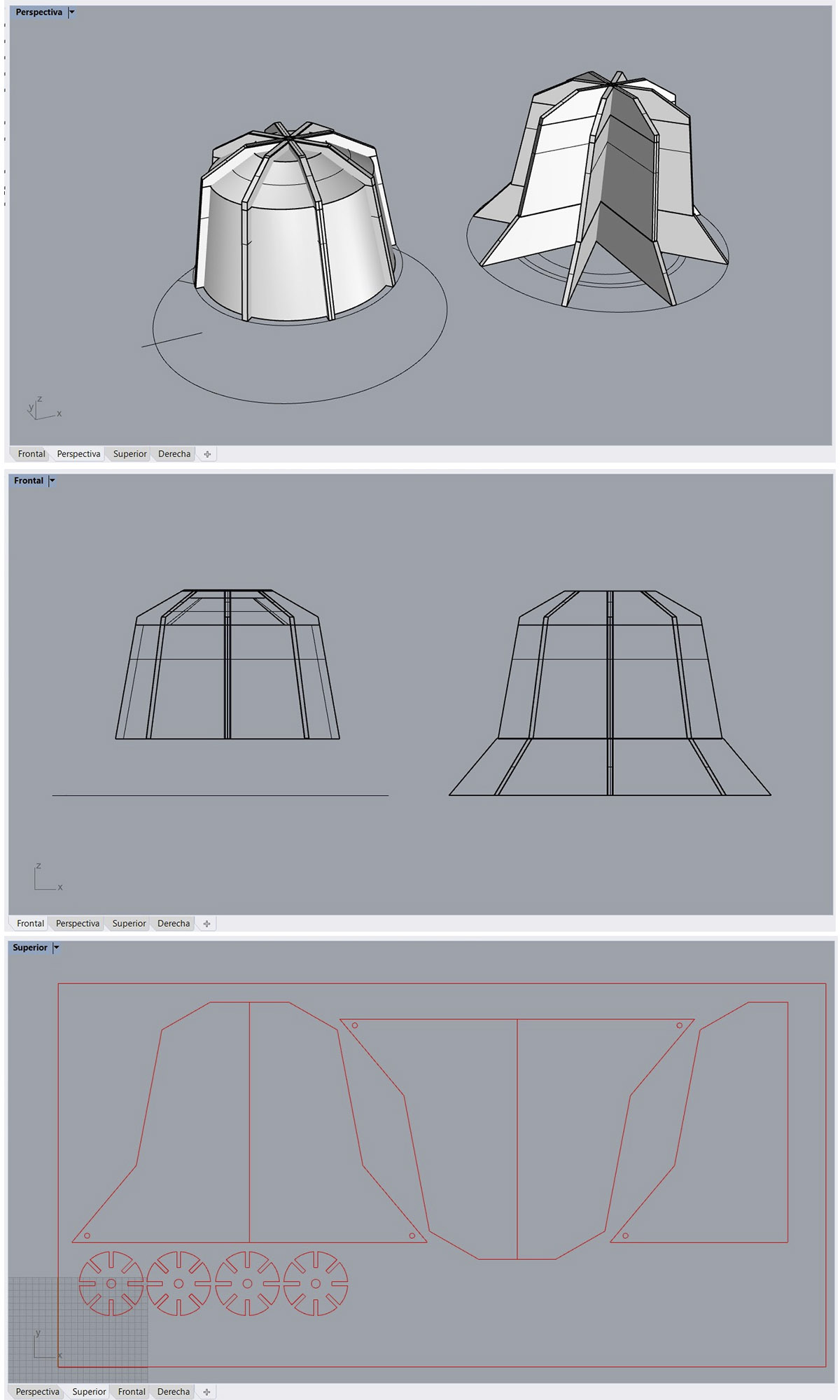
I started by designing the volume in 3D in Rhino, to visualize the shape that the volume covered in thread would take and then creating the sections in which it would be supported. Although the piece in which I worked in the beginning could be printed in 3D and achieve perhaps more complexity in its form, it would take many hours consuming too much material; for which I decided to work in 2D for laser cutting and thus build a radial mold through pieces embedded in a vertical direction around an axis. Which can then be anchored to a rotating table. This process can be improved in the future by adding a crank or motor for its rotation
Step by Step:
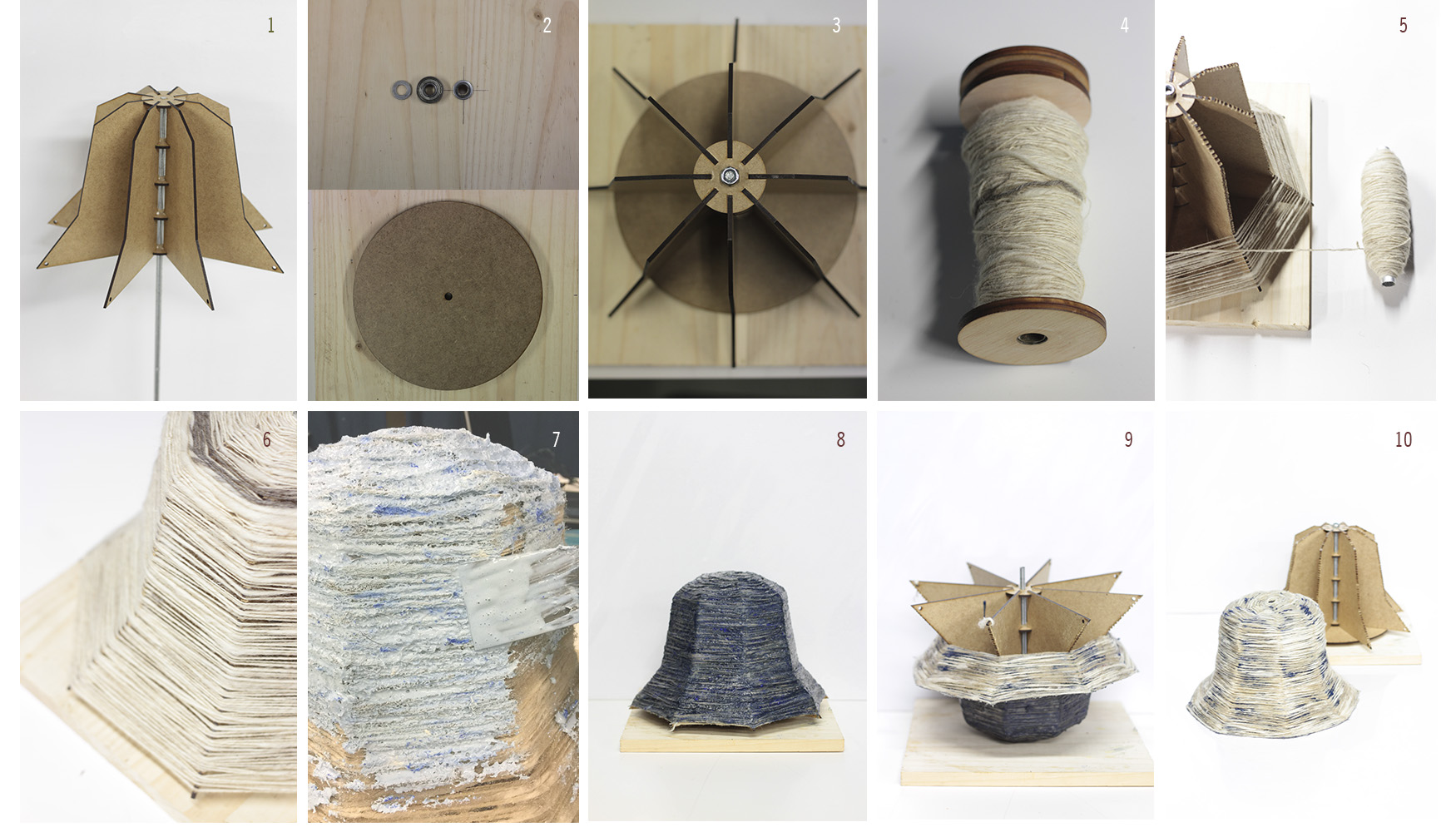
- 1 Pass the circles of horizontal axis by the threaded rod. Assemble the parts by reinforcing the inserts with glue.
- 2 Perform a central drilling to the base wood (diameter of the rod) and place the rotator and then a circular cut to facilitate the movement of the piece (without adding glue, so that the system can be dismountable later).
- 3 Mount the structure with the base and place a nut on the end of it, to avoid unscrewing.
- 4 Place the thread or wool in a coil.
- 5 Tie the end of the thread to one of the perforations in the lower part of the structure and begin to place the thread tightly around it, using the rotary movement.
- 6 Repeat the process, interspersed, until the surface is completely covered.
- 7 Coating the surface achieved with Latex (you can add colored pigment), using a spatula. Allow to dry and repeat if necessary, until the volume has a smooth surface and no holes.
- 8 Let the piece dry, preferably from one day to the next.
- 9 Unmold the hat, turning the piece.
- 10 hat achieved, is reversible, can be used on both sides, has a waterproof face and the other with the thread in sight.
Week 08. OPEN SOURCE HARDWARE - From Fibers to Fabric / Hilo Hat from Betiana Pavon on Vimeo.
Final Rsult#
